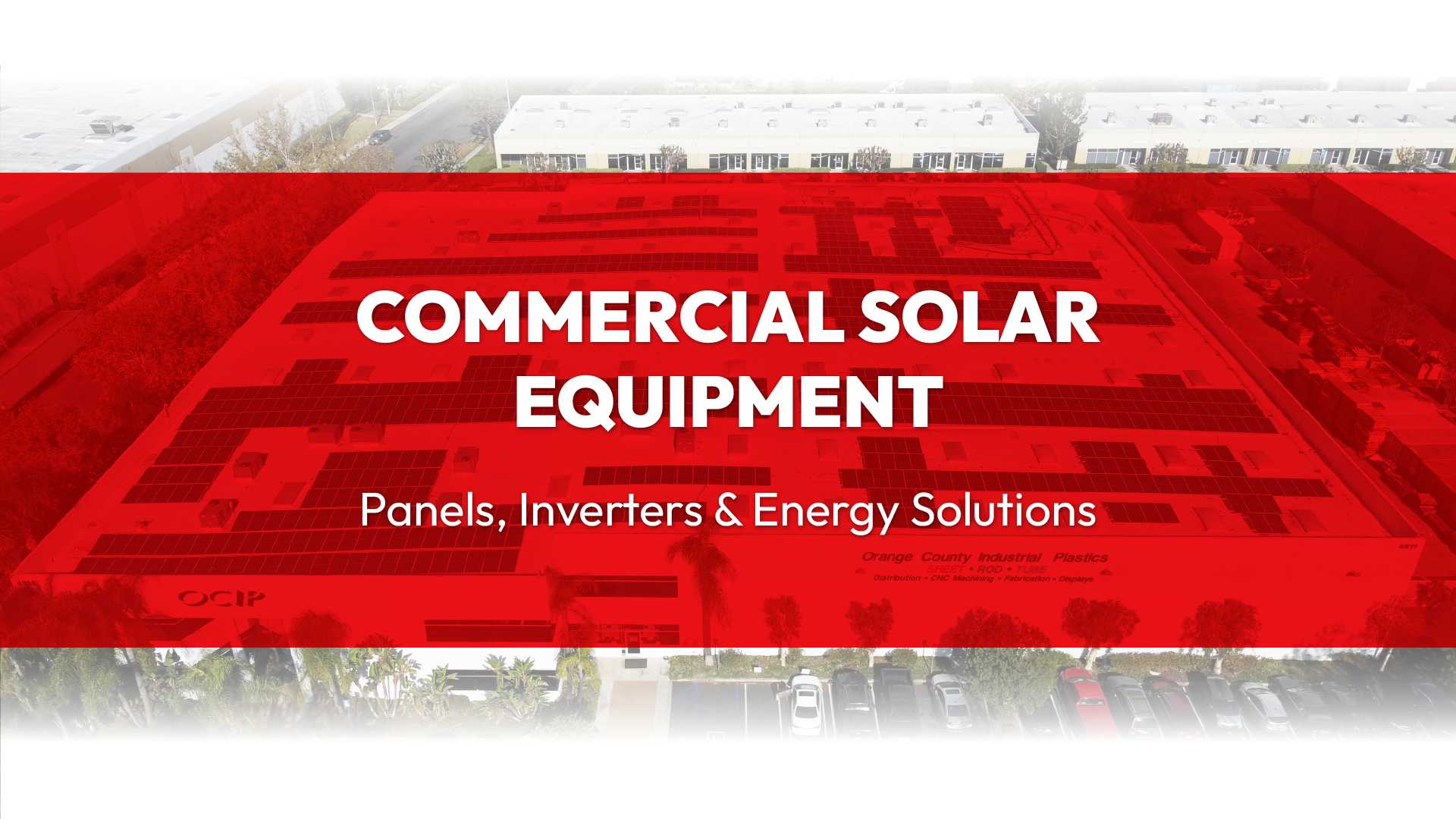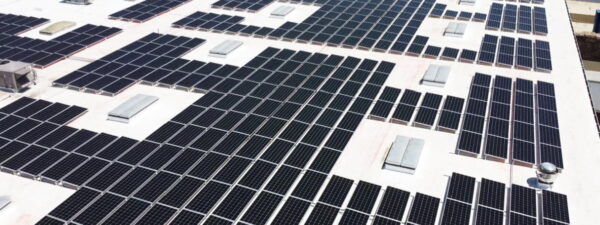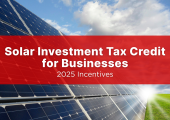Designing an efficient commercial solar system starts with understanding its moving parts. From solar panel selection to inverter configuration and storage integration, every component plays a role in maximizing energy output and financial performance.
Whether you’re planning a new facility, retrofitting an existing building, or scaling operations across multiple sites, this guide breaks down the core technologies, cost considerations, and strategic factors needed to navigate the commercial solar landscape with clarity and confidence.
What Is Commercial Solar Equipment?
Commercial solar equipment refers to the collection of specialized technologies that make up a solar energy system designed for non-residential use. Unlike residential systems, which are typically built to offset household electricity consumption, commercial solar systems are engineered to meet the significantly higher energy demands of office buildings, manufacturing plants, agricultural operations, and other energy-intensive operations.
At its core, commercial solar equipment enables businesses to convert sunlight into electrical energy, reduce dependency on the utility grid, and take control of their electricity costs. These systems can be installed on rooftops, over parking lots, on open land, or integrated into new construction projects—each with its own technical and logistical requirements.
Core Components of Commercial Solar Equipment
A successful commercial solar system is built from a combination of high-performing, interoperable components that work together to convert, store, and manage solar energy efficiently. Each part plays a crucial role in the overall performance, reliability, and return on investment of the system.
1. Commercial Solar Panels
Commercial panels are typically larger and more powerful than residential options, designed to deliver maximum output to meet high daily energy loads. They consist of photovoltaic (PV) cells that capture sunlight and begin the process of solar conversion, turning solar radiation into direct current (DC) electricity.
- Monocrystalline panels offer superior efficiency and longevity, making them ideal for businesses with limited space or high energy needs. These panels typically achieve efficiency ratings between 17% and 22%, with some top-tier models reaching up to 24.1%.
- Polycrystalline panels are a cost-effective option, though typically slightly less efficient, with efficiency ratings ranging from 15% to 17%.
- Bifacial panels can absorb light on both sides, increasing total power generation—especially when mounted over reflective surfaces like white rooftops or concrete. This technology can boost system efficiency by up to 30% compared to monofacial panels.
These panels are most often mounted on large rooftops, solar farms, or unused outdoor space, making them suitable for everything from office buildings to warehouses to agricultural fields.
2. Solar Inverters: String vs. Micro-Inverters
Once solar panels generate DC electricity, it must be converted into alternating current (AC) to power standard electric systems. This is the job of the solar inverter, which serves as the system’s electrical translator.
- String inverters are centralized and cost-effective, connecting multiple panels into a single conversion unit. However, they can suffer performance drops if even one panel is shaded or damaged.
- Micro-inverters, mounted on individual panels, allow for independent panel performance and monitoring. This boosts overall system efficiency and is ideal for rooftops with variable shading or complex layouts.
The choice between inverter types directly influences system design, scalability, and the total solar electricity generation your facility will achieve. Notably, microinverters have demonstrated higher reliability, with data indicating that less than 1 in 800 microinverters experience failure in the first two years of operation, compared to approximately 1 in 350 string inverters.
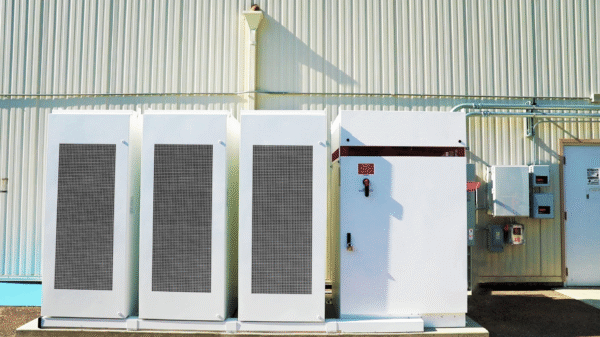
3. Battery Storage Systems
Battery storage is a growing priority for commercial solar adopters—especially those with off-grid systems, frequent power outages, or demand charges from utility companies.
- Lithium-ion batteries dominate the market for their compact size, high energy density, and long life cycles.
- These batteries store excess power generated during the day, enabling businesses to use it at night or during grid outages.
- Storage also supports peak shaving, helping reduce electricity costs by using stored energy during high-rate periods.
A well-designed battery storage system enhances energy resilience, reduces operating costs, and enables greater control over when and how your business consumes electrical energy.
4. Mounting & Racking Infrastructure
To perform effectively, solar panels must be securely anchored and positioned for maximum sun exposure. This is where mounting and racking systems come in.
- Ground-mounted systems are common in solar power plants or properties with available land. They offer flexibility in angle and orientation but require more space and permitting. Fixed-tilt racking systems are among the most common choices for ground mounts, offering simplicity and cost-effectiveness.
- Ballasted systems are ideal for flat commercial rooftops, requiring no roof penetration.
- Fixed-tilt and tracking systems offer different levels of complexity and sunlight optimization. Tracking systems can follow the sun’s movement throughout the day, increasing energy production, but at a higher installation and maintenance cost.
System durability must account for extreme weather events, including wind uplift and snow loads. Local codes, space requirements, and structural engineering assessments all influence final racking design.
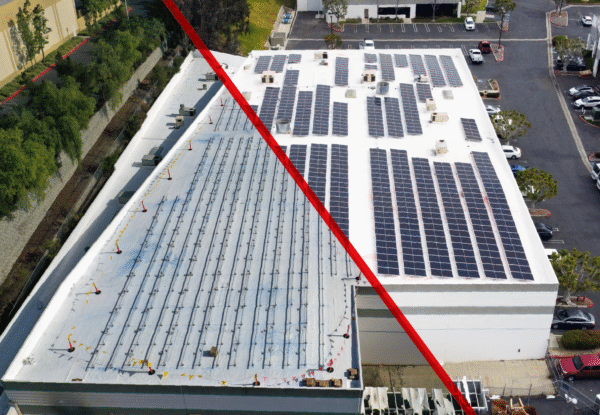
5. Energy Management & Monitoring Software
Modern solar installations benefit significantly from integrated software platforms that offer real-time performance monitoring, diagnostics, and load balancing.
- These systems enable solar energy modeling, helping predict output and adjust operations accordingly.
- Businesses gain access to actionable solutions, including alerts for inefficiencies, underperformance, or component degradation.
- Advanced platforms use machine learning to refine power usage patterns and deliver predictive maintenance insights.
Especially in multi-site or commercial operations, a robust management platform can drive further savings over time and reduce labor costs related to system oversight.
Planning for Commercial Solar: Space, Grid Access, and Load Profiles
Before selecting equipment, it’s essential to assess your site’s physical and electrical characteristics. Proper planning ensures your system delivers maximum output and avoids costly redesigns.
- Space requirements: Assess roof orientation, shading, and available outdoor space. Systems need about 100–200 sq ft per kW, depending on panel efficiency.
- Load profile analysis: Understanding your facility’s electricity consumption patterns (peak hours, seasonal loads) guides system sizing.
- Utility grid access: For grid-tied systems, ensure your connection supports net metering or power export. In remote areas, off-grid systems or hybrid solutions may be better.
- Solar site selection impacts long-term solar savings and integration with your electric systems.
👉 Pro tip: A solar consultant will often perform this analysis during the feasibility study.
Understanding the Costs: Investment & ROI
Now let’s explore one of the most important aspects of adopting commercial solar equipment: cost. While the initial investment can be significant, commercial solar systems are structured to deliver long-term savings, operational stability, and eligibility for financial incentives that improve return on investment.
Initial Investment vs. Long-Term Savings
The cost of installation for a commercial solar system varies based on system size, site conditions, and chosen technologies.
- Initial cost depends on scale, utility requirements, and equipment selection
- Many businesses see a full return on investment within 5 to 7 years
- Commercial installations typically qualify for larger-scale discounts and financing
Choosing a reputable solar installation company can also affect your total cost of ownership, installation quality, system efficiency, and long-term savings.
Reducing Costs with Incentives
Thanks to numerous solar incentives and tax incentives, the real cost can be significantly lower:
- Federal tax credits: The Investment Tax Credit (ITC) currently allows for 30% of the total system cost to be deducted from federal tax liability.
- Additional tax savings: Some states offer property tax exemptions, sales tax reductions, or local rebate programs.
- MACRS accelerated depreciation: The Modified Accelerated Cost-Recovery System allows businesses to depreciate 85% of the system cost over five years, providing significant additional tax savings.
- Utility programs: Many utilities offer performance-based incentives or renewable energy credits (RECs) that generate value as the system operates.
Operations, Maintenance & Cleaning: Protecting Your Investment
Once a commercial solar system is installed, maintaining peak performance becomes the priority. Routine maintenance is essential for maximizing the lifespan of your investment, ensuring safety, and preserving your expected return on investment. Without proper upkeep, system efficiency can decline, reducing the amount of usable electricity generated and compromising your financial savings.
- Regular cleaning: Dust, debris, bird droppings, and environmental residue can block sunlight and reduce panel efficiency. Routine washing—especially in agricultural, desert, or industrial zones—ensures panels perform at their rated capacity.
- Scheduled inspections: Inverters, batteries, and electrical connections require periodic checks to detect wear, corrosion, or voltage inconsistencies.
- Software diagnostics: Systems integrated with an intelligent energy management platform can self-monitor and flag underperformance, degradation, or component failures in real time.
- Maintenance after major updates: After hardware replacements or major updates, re-commissioning and recalibration may be required to re-optimize the system.
Businesses should budget for ongoing operating costs tied to maintenance and diagnostics to ensure that their solar investment continues to deliver savings over time.
Conclusion: Invest in a Smarter Energy Future
Commercial solar is not a one-size-fits-all solution—it’s an evolving ecosystem of equipment, strategy, and opportunity. With technologies advancing rapidly and financial incentives continuing to expand, today’s businesses are in a stronger position than ever to take control of their energy future.
For those willing to approach solar adoption with long-term thinking and technical precision, the payoff extends far beyond the meter. It means less exposure to volatile utility costs. Greater autonomy over energy use. A clear path toward decarbonization. And, perhaps most critically, a smarter infrastructure ready to power growth.
If you’re looking for a partner to help navigate the complexity of commercial solar adoption—Revel Energy brings the experience, technical expertise, and project management precision to deliver results that align with your business goals.
Contact Revel Energy for a consultation and start shaping a more resilient, cost-efficient, and sustainable energy foundation for your business.
Frequently Asked Questions (FAQ)
The solar panel installation cost ranges from $1.75–$2.50 per watt. Costs vary by site, but solar developers can design solutions based on budget, output needs, and incentive eligibility. The average cost for a midsize system is $100,000–$300,000 before incentives.
The solar tax credit, federal tax credits, and additional tax savings can reduce upfront costs by 30%, up to 50% with additional adders. States may also offer solar incentives or rebates.
Development time depends on permitting, solar site selection, solar plant design, interconnection approvals, and weather. On average, a project may take 3–9 months from design to commissioning.
Yes. Battery storage systems allow excess power to be saved and used during peak pricing, power outages, or when sunlight isn’t available. Lithium-ion batteries are widely used.
Most commercial buildings with adequate outdoor space or roof space are suitable. A solar consultant can assess space requirements, solar applications, and site viability.
Project management ensures timely permits, solar installation process coordination, and alignment with utility and financial goals. It’s critical for commercial installations with multiple stakeholders.
ROOFTOP SOLAR
Commercial grade rooftop solar is ideal for: manufacturing, warehousing, logistics, industrial, retail, hospitality buildings and more with over 10,000 sq. ft. rooftops.
CARPORT SOLAR
Free standing carport solar generates added solar power for properties with limited rooftop space. Added benefits include shading and protection for employees vehicles.
ENERGY STORAGE
Crucial for reducing peak demand charges. Automated to supply electricity when your panels won’t. Energy storage is ideal for businesses that incur significant peak charges.
EV CHARGING STATIONS
As the popularity of EVs increase, so does the demand for on-site EV charging stations. This sustainable amenity has become a parking lot fixture for employers.
CREATING CAPITAL THROUGH SUSTAINABILITY, WE OFFER:
PROFESSIONAL GUIDANCE
CUSTOM TAILORED PLANNING
ENGINEERING, PROCUREMENT, CONSTRUCTION & INSTALLATION
CSLB #1106092
Client Testimonial: Kelemen Company
Corporate Business Park in Irvine, CA has created significant electricity cost savings through commercial solar installed across the 5-building business park.
Client Testimonial: Tice Gardner & Fujimoto LLP
See how this CPA firm saved on electricity and gained valuable tax credits through commercial solar that they used to keep cash in the businesses.

